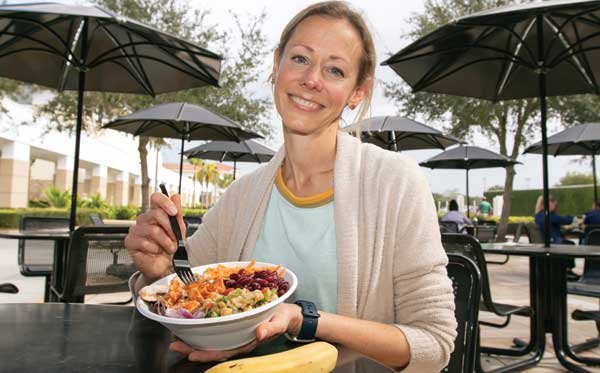NEW YEAR, NEW YOU: Health First Expert Kristine Van Workum Offers New Year's Nutrition Targets – SpaceCoastDaily.com
Home » NEW YEAR, NEW YOU: Health First Expert Kristine Van Workum Offers New Year’s Nutrition Targets
By Space Coast Daily // January 12, 2022
Nutritionists and dieticians say everyone’s favorite start-of-year resolution – losing weight – should include ‘non-diet’ steps like eating more of the right foods.
BREVARD COUNTY, FLORIDA – The traditional thing to do on New Year’s Eve is celebrate at midnight because the next morning we’re getting back in shape! About 1 in 3 Americans make New Year’s resolutions, and according to surveys, exercising, dieting and losing weight are the most popular.
If that’s your plan, Health First’s registered dietitians have the plan for you. Eat less and completely cut out carbs? Hmm, more like eat more better foods.
The “Non-diet” Trend
Diet and weight loss aren’t synonymous, says Kristine Van Workum, Clinical Dietitian for NewFit Bariatrics surgical weight loss program. Fad diets may result in weight loss, but they often provoke unwanted results such as slowing metabolism, listlessness and anxiety with food.
Consider approaching 2022 with a focus on health and wellbeing through a “non-diet” approach.
“I encourage patients to focus on eating mindfully, being present and tasting each bite of food whenever possible as well as appreciating how it can help fuel your body. Focus on how your body feels before, during, and after your meal and allow your fullness to guide you towards a comfortable stopping place. Paying attention is key,” said Van Workum.
Reducetarianism?
At Health First, our dieticians and nutritionists don’t recommend an entirely plant-based (vegan) menu, but reducing consumption of meats and cheeses in an average diet is usually a healthy step.
The authors of Whole Foods Market’s latest Trends Council report called this “reducetarianism” and named it a top trend for 2022.
A good rule of thumb is that as your plate of food becomes more colorful (think leafy greens and bright fruits and vegetables), nutrition improves.
Beets and Seeds
Beets served up a few punchlines in the hit comedy The Office a few years back – remember the beet farmer Dwight Shrute? – but these root vegetables should earn a recurring role on your plate.
For one, beets are slightly sweet and slightly starchy, making them unusually versatile in the kitchen and on the plate. Plus, they’re more colorful than your usual white potato and are high in folate, potassium, and vitamins A and C.
Also, “there’s been some research on beets and athletic performance,” says Van Workum. Beets can increase nitric oxide levels in the body which can help improve oxygen efficiency during exercise. They can also relax blood vessels thus improving blood pressure. Beets are also high in antioxidants, according to the journal Nutrients.
Meanwhile, sunflower seeds are having a moment in the diet-verse. Sunflower seeds are nut-free, so don’t lump them in with peanuts. They’re great in breads, crackers and crisps. The protein, fiber and healthy fats found in nuts and seeds help you feel satisfied, so they’re a great afternoon snack.
Seasonings
Variety may be the spice of life, but for our purposes, let’s focus on real spices. Two in particular – cinnamon and turmeric.
Both of these spices have prebiotic properties that aid the growth of beneficial bacteria inside our intestines and suppress the growth of pathogenic bacteria.
Preliminary research has shown cinnamon may have a direct impact on improving blood sugar control, while increasing antioxidants and flavoring foods without added sugar or salt.
Try cinnamon sprinkled on oatmeal, in smoothies or even in your morning cup of coffee; add a dash of cinnamon or cardamom on top of Greek yogurt & chopped fresh fruit.
Tumeric is called “the golden spice” for its color (it’s the yellow in curry) and health value. It’s been used in traditional medicines, especially in the East, as an anti-inflammatory and antioxidant. More and more, you’re seeing it in fizzy health drinks like kombucha.
Hydration
We’ve been talking food so much we’ve left out the water – which is often the problem. Face it, we don’t drink enough water. In our hospitals, we know that dehydration leads to all kinds of ill effects, starting with lethargy.
The U.S. National Academies of Sciences, Engineering, and Medicine determined that an average adult woman should take in about 11.5 cups (2.7 liters) of fluids a day, and an average adult male about 15.5 cups (3.7 liters). A bit of that comes from food, but it still leaves several cups on the table.
And remember, alcoholic drinks cause dehydration, and caffeinate is a diarrhetic. That is, they don’t replenish lost fluids but exacerbate its effects.
Self-satisfaction
Finally, make your New Year’s nutrition goal a happy (and resilient!) one: plan to win. According to experts, tricks to help it stick include these:
■ Make specific micro-goals: Instead of “lose 50 pounds,” set a behavior-change goal for something small that you have control over, such as drinking one more glass of water per day.
■ Mark your wins: Be your own accountant and keep a ledger of the steps you choose to achieve your resolution. Write out your specific action-oriented goal and post it somewhere you’ll see it.
■ Ask others to check in: Don’t stay quiet about your new year’s resolution. Tell a family member or friend about it. (Better still, buddy up with someone with a similar goal!)
■ Practice self-compassion and self-reward: Build in rewards for milestones, and if you fall short, tell yourself, “Bend, don’t break.”
To schedule a consultation with a specialist at Health First’s NewFit, call 321.434.9371, or visit HF.org/newfit to learn more.
Signup for Space Coast Daily News Email Alerts!




